For this project, we will be showing you how to run the popular Zoom client on a Raspberry Pi.
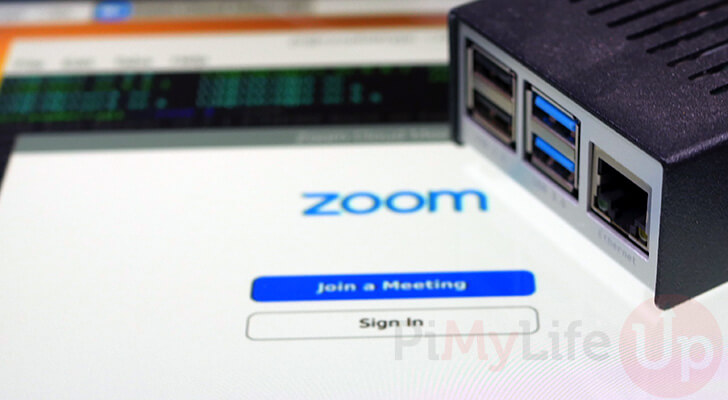
Zoom is a video and web conferencing tool that has become popular among organizations, schools, and consumers.
One of the biggest advantages of Zoom is its ease of use. You can join meetings without ever having to create your own account.
You can even use the tool to create meetings so that others can connect to you easily. However, the person making the meeting does require their own Zoom account.
The person that creates the meeting can dictate who can speak and share things such as their screen.
The free plan allows you to connect up to 100 other people with a 40-minute time restriction.
This guide will show you how to install the Zoom client to your Raspberry Pi.
As there are no ARM binaries available for Zoom, we will have to use a piece of software called box86.
Equipment
Below you can see a list of equipment we used when installing Zoom on to our Raspberry Pi.
Recommended
- Raspberry Pi Amazon
- Micro SD Card Amazon (8GB+)
- Ethernet Cable Amazon or Wi-Fi Amazon
- Raspberry Pi Camera Amazon or USB Webcam Amazon
Optional
Preparing your Raspberry Pi for Zoom
Running Zoom on the Raspberry Pi is not straightforward because it does not have any ARM binaries.
To get around this, we will be using a nifty piece of software called box86. Box86 is an emulation software that converts x86 instructions to the ARM instruction set that the Raspberry Pi understands.
1. Before you can proceed, you need to make sure you have compiled and installed box86 to your Raspberry Pi.
You can follow our tutorial on getting x86 emulation running on your Raspberry Pi.
2. Once you have box86 installed, we can now do the rest of our preparation work.
Let us update our Raspberry Pi’s operating system by running the following two commands.
sudo apt update
sudo apt full-upgrade3. Once your Raspberry Pi finishes updating, we need to install some additional software.
Zoom requires a library that isn’t available on the OS by default, but we can install it from the package repository.
sudo apt-get install libxcb-xtest0This library is libxcb-xtest0. The Zoom client uses this library to interact with the X window system.
Installing Zoom on the Raspberry Pi
With our Raspberry Pi prepared, we can finally move install the Zoom client to the device.
These steps get a bit involved as we need to download the 32bit version of Zoom and extract it from the Debian package.
1. First, make sure that we are at the root of our user’s home directory.
This ensures we aren’t downloading Zoom into a random directory.
You can change to the root of the user’s home directory by running the following cd command.
cd ~2. Let us download the 32-bit Zoom client to our Raspberry Pi by using the wget command.
This archive contains the compiled version of Zoom that we need for our operating system.
We can’t use the typical Debian package due to it detecting that our system shouldn’t be compatible due to it not being available for ARM.
wget https://zoom.us/client/5.4.53391.1108/zoom_i686.tar.xzPlease note that this may not be the latest version of Zoom. You can get the latest download link from the Zoom website.
When using the website to grab the latest download link, select “Other Linux OS” for type. Then select “32 bit” for OS Architecture.
Once selected, you should be able to right-click the download button and copy the link.
3. With the archive downloaded to our Pi, we can extract the Zoom binaries from it.
To extract files from the archive, we can use the following tar command on our device.
tar xvf zoom_i686.tar.xzRunning Zoom from the Desktop Interface
With Zoom now extracted to your Raspberry Pi, we can now run it using the box86 emulator.
Thanks to box86, this is a reasonably straightforward process and can be done in a single command.
To launch Zoom on your Raspberry Pi, you need to make sure you are running a version of the operating system that has the desktop.
You obviously can’t run Zoom over an SSH connection to your Raspberry Pi.
1. On your device, we need to change to the directory that we extracted in the previous section.
This directory is where the Zoom application is now sitting on your device.
cd /home/pi/zoom2. Once in the directory, we can launch the Zoom client on our Raspberry Pi.
All we need to do is use the following command to launch the client.
./zoom3. You can now join in on Zoom meetings from your device.
If you have an account, you can even host your own meeting straight from your Raspberry Pi.
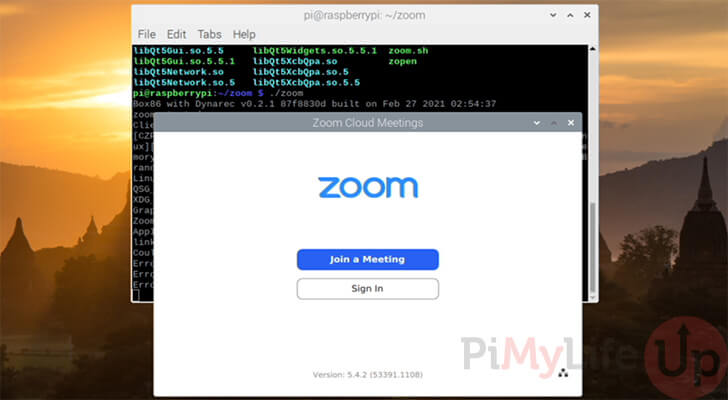
When you first connect to a meeting, you may have to change your webcam and microphone settings. The defaults for these on the Raspberry Pi are often incorrect.
Conclusion
At this point, you should now have successfully installed and ran Zoom on your Raspberry Pi.
Zoom is a remarkable media conferencing tool that can be useful to run on your Pi, thanks to its enormous rise in usage.
Considering the Zoom client is running within an x86 emulator, it runs incredibly well. It can utilize a connected USB webcam or even the Raspberry Pi camera.
If you have run into any issues with getting Zoom to work, please leave a comment below.
Additionally, be sure to check out our other great Raspberry Pi projects.


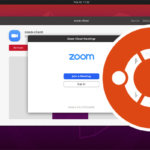


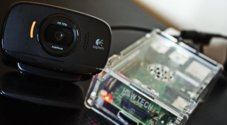

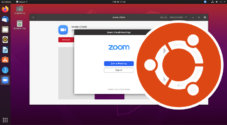
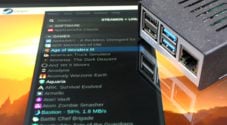

Any thoughts on whether or not this will work on a PI 5?
Hi Randy,
I can’t see why it wouldn’t. Let me know if you have any issues and I can try looking into it.
Kind regards,
Emmet
Thanks Emmet.
What about the additional library I installed “libxcb-xtest0” ?
Can that be removed too?
Hi Tachy,
Yes it should be safe to remove that library a well.
Cheers,
Emmet
How do I uninstall both Zoom and Box86?
I got it all working but now my system randomly freezes while doing other things and takes forever too boot since installing Box86.
Hi Tachy,
That is unusual as Box86 should only run whenever you are using an x86 program.
However, if you want to try removing both to see if it resolves your issues you can use the following steps.
The following steps will assume that your user is called “pi”. Switch out “pi” with the username you are using.
1. First, removing Zoom is simple since we only ever extract the archive of it, we never actually install the program elsewhere.
Use the following command to remove the extracted directory.
2. Secondly, removing box86 should also be straightforward as well thanks to it having uninstall functionality within its makefile.
Use the following two commands to change to the build directory and then to run the uninstall command.
Please let me know if this works for you.
Cheers,
Emmet
“Box86 with Dynarec v0.2.3 1955c225 built on Oct 10 2021 00:04:24
zoom started.
Client: Breakpad is using Single Client Mode! client fd = -1
free(): invalid pointer
Aborted”
Anyone got into this problem?
Hi Dude777,
Can you try recompiling box86 but using the last tag release (At time of writing this comment, this would be v0.2.2.
You can do this by using the following command within the box86’s source code directory.
There appears to be some bugs introduced in some of the new commits so may have to wait a bit of time for these to be ironed out.
Whenever you want to switch back to the latest code you can change back to the “master” branch and pull the latest code by using the following commands within the source code directory.
Cheers,
Emmet
do you happen to know if this works on a Pi3B+ or only on PI4s?
Hi Bob,
While this will work on a Raspberry Pi 3B+ you will get your best experience with the latest Raspberry Pi.
Cheers,
Emmet
I’ve tried on a Pi3B+, but it’s unusable. Almost all the RAM is used up, even without starting another program. I tried connecting to a meeting but wasn’t successful.
Thanks for the great tutorial, with it I finally got zoom working on my raspberry.
The only thing I’m still struggling with is to get the raspberry CSI camera to work with zoom. It appears in the camera selection, but always gives a black image. Any help would be very appreciated.
Cheers,
Peter
I gave up on trying to use a raspberry pi camera for videoconferencing. A USB webcam gives much better results.
Hi Emmet! I followed all the steps, but when I try ./zoom I get “bash: ./zoom: cannot execute binary file: Exec format error”
Hi Armahni,
Please make sure that you have installed box86 to your Raspberry Pi.
Without that emulator you will not be able to use the Zoom software and will run into the error you mentioned.
Cheers,
Emmet
Yes the audio emulation from the rpi4 seems to be faulty, there is a thread with this issue on github.
I’ve tried many times to get this to work but end up going back to my Windows laptop for now, shame as the pi4 has been able to handle a Zoom meeting with 15 people on a 42″ TV excellently.
This is just the zoom client correct? Not a zoom server.
Thanks for this, and Box86 should be able to run all x86 apps on arm processors (no special compiling needed)
Hi Brian,
Yes this is just the zoom client though you should still be able to create meetings using it.
Box86 is still fairly early on, but yes it is capable of running x86 apps on an ARM processor. It basically reads in the x86 instructions and attempts to recompile it into ARM.
Cheers,
Emmet
Hi!
Thanks for the tutorial! I forgot that after the box86 installation I was still in that folder in the terminal, so don’t forget to change back to the folder you want zoom te be installed in.
Installation was successful, and I had fine webcam footage and received sound on the raspberry. However, on my ‘normal’ windows laptop I only received audio noise from the RPi microphone. Switching back to browser I received normal audio. Has anyone else had this problem and/or does anyone know if I can fix this or if it’s a problem with the software?
Greets,
Bas